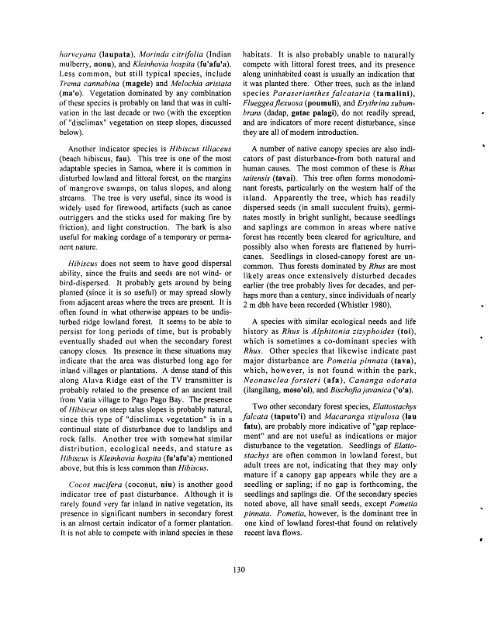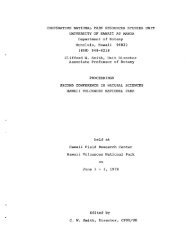american samoa - University of Hawaii at Manoa
american samoa - University of Hawaii at Manoa
american samoa - University of Hawaii at Manoa
You also want an ePaper? Increase the reach of your titles
YUMPU automatically turns print PDFs into web optimized ePapers that Google loves.
harvcyana (laup<strong>at</strong>a), Morinda citrifolia (Indian<br />
mulberry, nonu), and Kleinhovia hospita (fu'afu'a).<br />
Less common, but still typical species, include<br />
7'rema cannabina (magele) and Melochia arist<strong>at</strong>a<br />
(ma'o). Veget<strong>at</strong>ion domin<strong>at</strong>ed by any combin<strong>at</strong>ion<br />
<strong>of</strong> these species is probably on land th<strong>at</strong> was in culti-<br />
v<strong>at</strong>ion in the last decade or two (with the exception<br />
<strong>of</strong> "disclimax" veget<strong>at</strong>ion on steep slopes, discussed<br />
below).<br />
Another indic<strong>at</strong>or species is Hibiscus tiliaceus<br />
(beach hibiscus, fau). This tree is one <strong>of</strong> the most<br />
adaptable species in Samoa, where it is common in<br />
disturbed lowland and littoral forest, on the margins<br />
<strong>of</strong> mangrove swamps, on talus slopes, and along<br />
streams. The tree is very useful, since its wood is<br />
widely used for firewood, artifacts (such as canoe<br />
outriggers and the sticks used for making fire by<br />
friction), and light construction. The bark is also<br />
useful for making cordage <strong>of</strong> a temporary or perma-<br />
nent n<strong>at</strong>ure.<br />
Hibiscus does not seem to have good dispersal<br />
ability, since the fruits and seeds are not wind- or<br />
bird-dispersed. It probably gets around by being<br />
planted (since it is so useful) or may spread slowly<br />
from adjacent areas where the trees are present. It is<br />
<strong>of</strong>ten found in wh<strong>at</strong> otherwise appears to be undis-<br />
turbed ridge lowland forest. It seems to be able to<br />
persist for long periods <strong>of</strong> time, but is probably<br />
eventually shaded out when the secondary forest<br />
canopy closes. Its presence in these situ<strong>at</strong>ions may<br />
indic<strong>at</strong>e th<strong>at</strong> the area was disturbed long ago for<br />
inland villages or plant<strong>at</strong>ions. A dense stand <strong>of</strong> this<br />
along Alava Ridge east <strong>of</strong> the TV transmitter is<br />
probably rel<strong>at</strong>ed to the presence <strong>of</strong> an ancient trail<br />
li-om V<strong>at</strong>ia village to Pago Pago Bay. The presence<br />
<strong>of</strong> Hibiscus on steep talus slopes is probably n<strong>at</strong>ural,<br />
since this type <strong>of</strong> "disclimax veget<strong>at</strong>ion" is in a<br />
continual st<strong>at</strong>e <strong>of</strong> disturbance due to landslips and<br />
rock falls. Another tree with somewh<strong>at</strong> similar<br />
distribution, ecological needs, and st<strong>at</strong>ure as<br />
Hibiscus is Kleinhovia hospita (fu'afu'a) mentioned<br />
above. but this is less common than Hibiscus.<br />
Cocos nucifera (coconut, niu) is another good<br />
indic<strong>at</strong>or tree <strong>of</strong> past disturbance. Although it is<br />
rarely found very far inland in n<strong>at</strong>ive veget<strong>at</strong>ion, its<br />
presence in significant numbers in secondary forest<br />
is an almost certain indic<strong>at</strong>or <strong>of</strong> a former plant<strong>at</strong>ion.<br />
It is not able to compete with inland species in these<br />
habit<strong>at</strong>s. It is also probably unable to n<strong>at</strong>urally<br />
compete with littoral forest trees, and its presence<br />
along uninhabited coast is usually an indic<strong>at</strong>ion th<strong>at</strong><br />
it was planted there. Other trees, such as the inland<br />
species Paraserianthes falc<strong>at</strong>aria (tamalini),<br />
Flueggeaflexuosa (poumuli), and Erythrina subum-<br />
brans (dadap, g<strong>at</strong>ae palagi), do not readily spread,<br />
and are indic<strong>at</strong>ors <strong>of</strong> more recent disturbance, since<br />
they are all <strong>of</strong> modem introduction.<br />
A number <strong>of</strong> n<strong>at</strong>ive canopy species are also indi-<br />
c<strong>at</strong>ors <strong>of</strong> past disturbance-from both n<strong>at</strong>ural and<br />
human causes. The most common <strong>of</strong> these is Rhus<br />
taitensis (tavai). This tree <strong>of</strong>ten forms monodomi-<br />
nant forests, particularly on the western half <strong>of</strong> the<br />
island. Apparently the tree, which has readily<br />
dispersed seeds (in small succulent fruits), germi-<br />
n<strong>at</strong>es mostly in bright sunlight, because seedlings<br />
and saplings are common in areas where n<strong>at</strong>ive<br />
forest has recently been cleared for agriculture, and<br />
possibly also when forests are fl<strong>at</strong>tened by hurri-<br />
canes. Seedlings in closed-canopy forest are un-<br />
common. Thus forests domin<strong>at</strong>ed by Rhus are most<br />
likely areas once extensively disturbed decades<br />
earlier (the tree probably lives for decades, and per-<br />
haps more than a century, since individuals <strong>of</strong> nearly<br />
2 m dbh have been recorded (Whistler 1980).<br />
A species with similar ecological needs and life<br />
history as Rhus is Alphitonia zizyphoides (toi),<br />
which is sometimes a co-dominant species with<br />
Rhus. Other species th<strong>at</strong> likewise indic<strong>at</strong>e past<br />
major disturbance are Pometia pinn<strong>at</strong>a (tava),<br />
which, however, is not found within the park,<br />
Neonauclea forsteri (afa), Cananga odor<strong>at</strong>a<br />
(ilangilang, moso'oi), and Bisch<strong>of</strong>ia javanica ('o'a).<br />
Two other secondary forest species, El<strong>at</strong>tostachys<br />
falc<strong>at</strong>a (taputo'i) and Macaranga stipulosa (lau<br />
f<strong>at</strong>u), are probably more indic<strong>at</strong>ive <strong>of</strong> "gap replace-<br />
ment" and are not useful as indic<strong>at</strong>ions or major<br />
disturbance to the veget<strong>at</strong>ion. Seedlings <strong>of</strong> El<strong>at</strong>to-<br />
stachys are <strong>of</strong>ten common in lowland forest, but<br />
adult trees are not, indic<strong>at</strong>ing th<strong>at</strong> they may only<br />
m<strong>at</strong>ure if a canopy gap appears while they are a<br />
seedling or sapling; if no gap is forthcoming, the<br />
seedlings and saplings die. Of the secondary species<br />
noted above, all have small seeds, except Pometia<br />
pinn<strong>at</strong>a. Pometia, however, is the dominant tree in<br />
one kind <strong>of</strong> lowland forest-th<strong>at</strong> found on rel<strong>at</strong>ively<br />
recent lava flows.
















